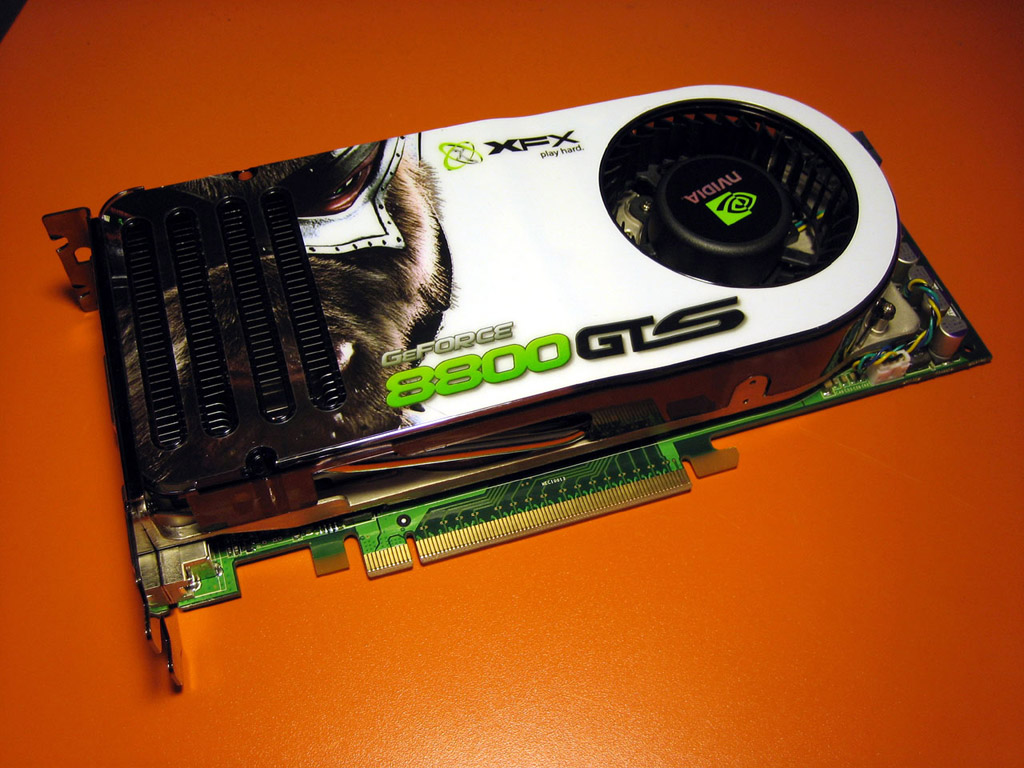XFX GeForce 8800 GTS 320MB Hands-On Preview
DirectX 10 just got more affordable! Find out more about the GeForce 8800 GTS 320MB in our hands-on report.
Nvidia has the DirectX 10 graphics technology lead and isn't hesitant about pushing it even though the content is still months away. The company didn't bother to wait for the release of Windows Vista before unleashing its GeForce 8800 DirectX 10 GPUs. The Santa Clara-based green giant launched its 8800 series of GPUs late last year targeting the early adopters with two high-performance, high-price GTX and GTS models. Now Nvidia is releasing the GeForce 8800 GTS 320MB model to give fresh Vista owners a more affordable DX10 video card option. The card comes with half the RAM of its $400 GeForce 8800 GTS 640MB sibling, but it also has a lower $300-350 MSRP.
The GeForce 8800 GTS 320MB comes with 96 floating point processors, the same as the original 640MB GTS but still less than the flagship 128-processor GeForce 8800 GTX. Stock GeForce 8800 GTS 320MB cards will come with a 500MHz core clock paired with a 1.2GHz shader clock. The 320MB of GDDR3 memory has an effective speed of 1.6GHz. Nvidia recommends a 400W power supply for the standard GeForce 8800 GTS 320MB card.
Expect to see several GeForce 8800 GTS 320MB variants out there because the video card manufacturers can adjust memory and GPU clock speeds to create more premium models. XFX sells an overclocked XXX model with a 580MHz core and 1.8GHz memory for $335.
| GeForce 8800 GTS 320MB | XFX GeForce 8800 GTS XXX | GeForce 8800 GTS 640MB | |
|---|---|---|---|
| Price | $300 | $335 | $400 |
| DirectX | DirectX 10, SM4 | DirectX 10, SM4 | DirectX 10, SM4 |
| Transistors | 681M | 681M | 681M |
| Core Speed | 500MHz | 580MHz | 500MHz |
| Stream Processors | 96 | 96 | 96 |
| Shader Speed | 1.2GHz | 1.8GHz | 1.2GHz |
| Memory | 320MB | 320MB | 640MB |
| Memory Speed | 800MHz (1.6GHz GDDR3) | 900MHz (1.8GHz GDDR3) | 800MHz (1.6GHz GDDR3) |
| Memory Interface | 320-bit | 320-bit | 320-bit |
The GeForce 8800 GTS 320MB has the same core improvements as other 8800-based GPUs. You'll get a unified shader architecture, full DirectX 10 compatibility, and support for concurrent high dynamic range lighting with antialiasing. The 8800 series of GPUs can also improve image quality for H.264 and VC-1 high-definition video content. Nvidia's current Windows Vista driver is stable, but performance isn't up to XP levels yet.
We tested the XFX GeForce 8800 GTS 320MB XXX edition and then underclocked the card to standard speeds to get performance results for the reference GTS 320MB.
Performance Charts
When do you plan on upgrading to a DirectX 10 video card? Share your thoughts in the comments below.
* Editor's Note: The Radeon X1950 XTX was unable to run Company of Heroes with 4xAA and 16xAF. System Setup: Intel Core 2 X6800, Intel 975XBX2, 2GB Corsair XMS Memory (1GB x 2), 160GB Seagate 7200.7 SATA Hard Disk Drive, Windows XP SP2. Graphics Cards: GeForce 8800 GTX 768MB, GeForce 8800 GTS 640MB, Radeon X1950 XTX 512MB, XFX GeForce 8800 GTS 320MB XXX. Graphics Driver: Catalyst 7.1, Forceware 97.92.
Conclusion
The GeForce 8800 GTS 320MB performs in line with our expectations. It's a quick card, but it does have memory limitations. The card performs wonderfully at 1600x1200 with 4x antialiasing, but falls behind when memory size comes into play at the highest resolution and image quality settings. The stock GeForce 8800 GTS 320MB is a great option if you're willing to sacrifice AA and AF settings for higher frame rates. If you can't live without the higher-resolution and antialiasing settings, you might want to consider jumping up to the 640MB GTS or the 768MB GTX.
When do you plan on upgrading to a DirectX 10 video card? Share your thoughts in the comments below.
Got a news tip or want to contact us directly? Email news@gamespot.com

Join the conversation